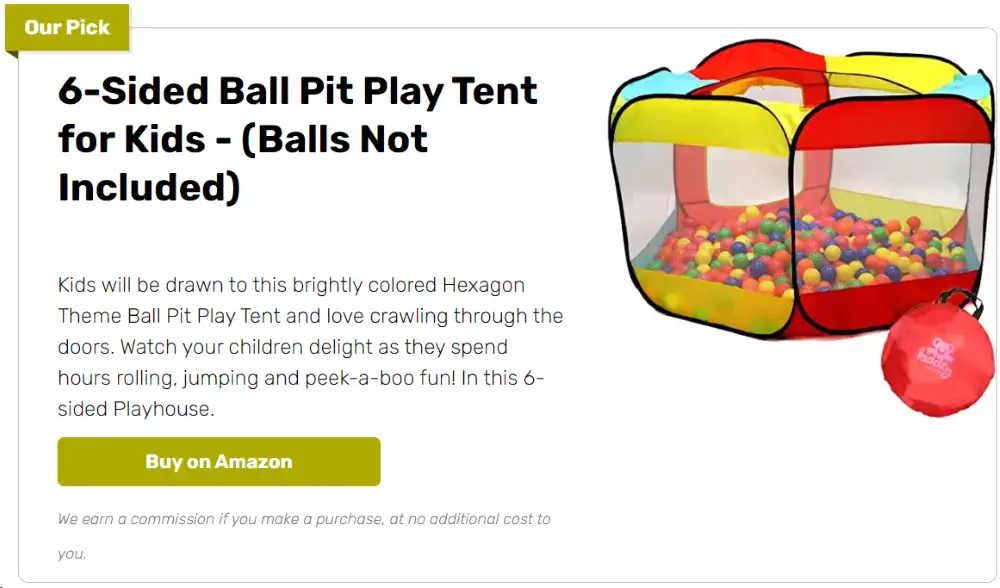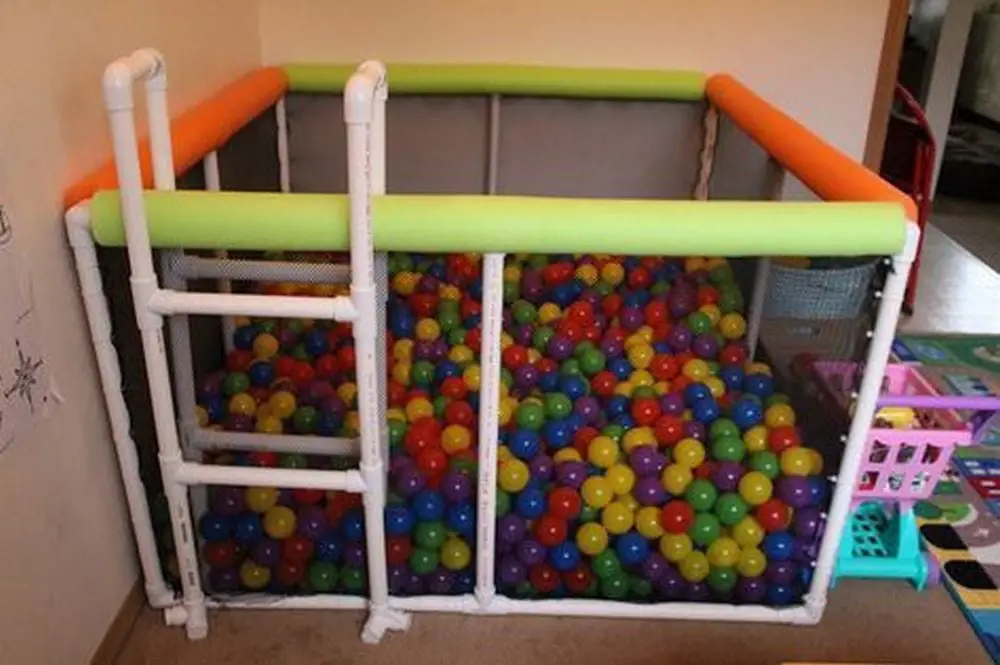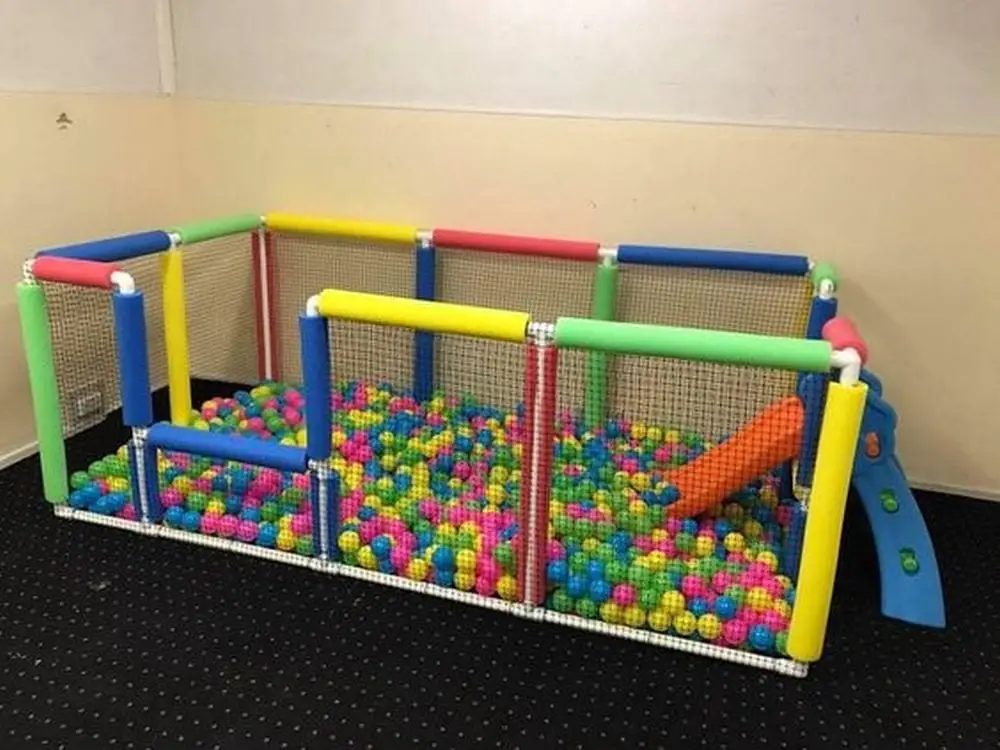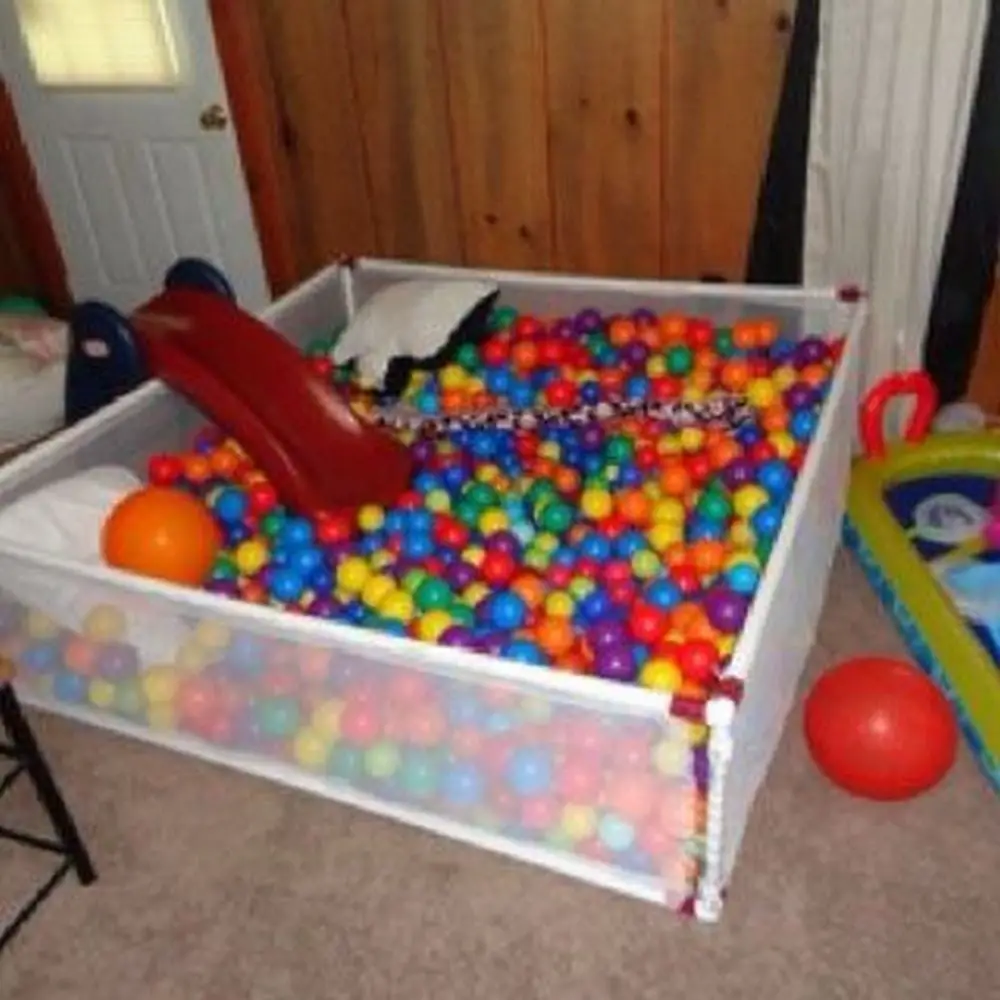
Play-places are sprouting up like mushrooms. They’re almost everywhere lately. Although they are quite tempting, I refuse to bring my children there because I have heard several horror stories from my co-parents. Apparently, some kids have acquired foot and mouth disease from the play-places, specifically the ball pits. Well, these may be isolated cases but I won’t risk it. So I decided to make my own PVC ball pit.

As a mother, I don’t want to deprive my kids of the experience of playing in ball pits. So guess what I did? I made a ball pit at home. It’s a fairly easy project that involves connecting PVC pipes and putting in some netting. You and your husband, partner, or friend can work on this and finish in less than a day.

Don’t put it off any longer and start making a ball pit today! Your kids will surely enjoy playing in it. Not only that, but you also get the peace of mind knowing they’re safe.
Contents
- 1 Building a PVC Ball Pit
- 2 Maintenance and Care of Your PVC Ball Pit
- 3 Safety Tips for Home Ball Pits
- 4 FAQ for Building a PVC Ball Pit
- 4.1 How much does it cost to build a PVC ball pit?
- 4.2 How many balls are needed for a standard-sized ball pit?
- 4.3 Is it safe for toddlers to play in a PVC ball pit?
- 4.4 Can the PVC ball pit be used outdoors?
- 4.5 How often should the PVC ball pit be cleaned?
- 4.6 What are the best ways to store the PVC ball pit when unused?
- 4.7 Can the PVC ball pit be customized in size?
- 4.8 How do I ensure the PVC ball pit is stable and safe?
- 4.9 Are there any specific maintenance tips for the netting?
- 4.10 Can I add a cover to the PVC ball pit for hygiene purposes?
- 5 Conclusion
Building a PVC Ball Pit
Materials:
- PVC pipes
- 3-way corner (“Y”)
- Netting
- Balls
- Cable ties
- Screws/PVC glue
- Pool Noodles
- T-elbow connectors
Tools:
- Scissors
- Screwdriver
Instructions:
- Plan the Size and Shape: Decide on the size and shape of your ball pit. Sketch a basic design to guide your construction.
- Cut PVC Pipes: Using your plan, measure and cut the PVC pipes to the desired lengths. Smooth any rough edges with sandpaper.
- Assemble the Base Frame: Connect the PVC pipes using T-elbow connectors to form the base of your ball pit. Use 3-way corner connectors for corners.
- Build the Walls: Attach vertical PVC pipes at each corner and connect them at the top using T-elbow connectors, forming the walls.
- Secure Joints: Use screws or PVC glue to secure all connections. Ensure everything is tightly fastened and stable.
- Attach the Netting: Cut the netting to cover the sides of the ball pit. Secure it to the PVC frame using cable ties. Trim excess netting for a neat finish.
- Add Pool Noodles for Safety: Slice pool noodles lengthwise and fit them over the exposed PVC edges. This step provides a soft, safe edge to your ball pit.
- Fill with Balls: Once the structure is complete and secure, add the plastic balls to the pit.
- Final Check: Do a final check to ensure all parts are securely attached and there are no sharp edges.
Maintenance and Care of Your PVC Ball Pit
Keeping your PVC ball pit in top condition is vital for safety and longevity. Regular maintenance ensures a clean, safe play environment for your kids. Here are essential tips to maintain and care for your PVC ball pit.
Regular Cleaning
Maintaining the cleanliness of your PVC ball pit is crucial for ensuring a safe and hygienic play area. Here’s how to effectively clean both the balls and the PVC structure.
Cleaning the PVC Structure
- Prepare a Cleaning Solution: Mix a mild soap with warm water. This solution is effective yet gentle enough not to damage the PVC material.
- Wipe Down the PVC Pipes: Use a soft cloth or sponge dipped in the soap solution. Gently scrub the PVC pipes of your ball pit. Focus on joints and connectors where dirt might accumulate.
- Rinse and Dry: Rinse the PVC pipes with clean water after wiping. Dry them thoroughly with a clean towel or let them air dry. Moisture left on the PVC can lead to mildew or mold growth.
Cleaning the Plastic Balls
- Prepare a Disinfectant Solution: Mix a gentle, non-abrasive disinfectant with water. Ensure it’s safe for use on plastic surfaces.
- Soak the Balls: Immerse the plastic balls in the solution. Allow them to soak sufficiently to kill any germs or bacteria.
- Rinse Thoroughly: After soaking, rinse the balls with clean water to remove any soap or disinfectant residue.
- Dry Completely: Spread the balls on a clean surface to air dry. Ensure they are completely dry before returning them to the pit to prevent mold growth.
Inspecting the PVC Structure
Regular inspections of your PVC ball pit’s structure are key to ensuring its safety and durability. Here’s a detailed guide on how to conduct these inspections.
Checking PVC Pipes and Connectors
- Visual Inspection: Begin with a thorough visual check of all PVC pipes. Look for cracks, splits, or any signs of wear and tear. Even small fractures can weaken the structure.
- Physical Check: Gently apply pressure to various parts of the PVC structure to test its stability. This helps identify any hidden weaknesses in the pipes.
- Inspect Connectors: Examine all connectors and joints. Make sure they fit snugly and haven’t loosened over time. Loose connectors can compromise the integrity of your PVC ball pit.
Securing Connections
- Tighten Cable Ties: Check their tightness if your PVC ball pit uses cable ties. Loose cable ties can lead to wobbly structures. Tighten them as necessary, but avoid over-tightening as this can cause stress on the PVC pipes.
- Replace Damaged Parts: If you find any damaged PVC pipes or connectors, replace them immediately. Using damaged components can risk the structure collapsing.
Regular Schedule
- Set a Routine: Establish a regular schedule for inspecting your PVC ball pit. Monthly inspections are generally sufficient, but consider more frequent checks if the ball pit is used often.
- Post-Use Inspection: After heavy use, such as during a party, quickly check the structure to ensure everything remains in place and secure.
Storage Solutions
Proper storage of your PVC ball pit when not in use is essential for preserving its condition. Here’s how to store the PVC structure and balls effectively.
Dismantling the PVC Structure
- Careful Disassembly: Take apart the PVC ball pit gently. Rushing the process can damage the connectors or pipes. Keep track of all parts to ensure easy reassembly.
- Organize Components: As you dismantle, organize the PVC pipes, connectors, and other components. This organization aids in quick and efficient reassembly later.
Storing PVC Pipes and Connectors
- Choose the Right Location: Store the PVC parts in a dry, cool area. Avoid places with extreme temperatures or humidity, as these conditions can cause warping or damage to the PVC material.
- Proper Arrangement: Arrange the PVC pipes and connectors neatly. This prevents them from bending or getting scratched. You might use storage bins or shelves for better organization.
Protecting the Balls
- Use Mesh Bags or Containers: Store the plastic balls in mesh bags or large containers. Mesh bags allow airflow, preventing moisture buildup. Containers protect the balls from being crushed or lost.
- Clean Before Storing: Ensure the balls are clean and dry before storing. This step prevents mold and keeps them ready for the next use.
Tips for Long-Term Storage
- Check Occasionally: If storing your PVC ball pit for an extended period, check on it occasionally. This check-up ensures no damage has occurred during storage.
- Avoid Heavy Stacking: Don’t stack heavy items on top of the PVC pipes and connectors. Excessive weight can deform or damage them.
Following these maintenance and care tips will ensure your kids’ PVC ball pit remains a fun and safe play area. Regular upkeep preserves the structure and ensures endless enjoyment for your children.
Click on any image to start the lightbox display. Use your Esc key to close the lightbox.









Safety Tips for Home Ball Pits
Creating a PVC ball pit at home provides endless fun for kids, but safety is paramount. These tips ensure your home ball pit is enjoyable and a secure play area.
Choose the Right Location
When setting up a PVC ball pit, the location is crucial in its safety and maintenance. You have to decide whether to place the ball pit indoors or outdoors. Indoor ball pits have the advantage of being easier to keep clean and safe from weather elements. They’re protected from rain, wind, and extreme temperatures, which can affect the durability of the PVC structure and the cleanliness of the balls.
Additionally, the surface on which you place the ball pit is important. Positioning the ball pit on a flat, even surface is essential. This ensures the structure remains stable and prevents tipping or wobbling during use.
An uneven surface can lead to accidents, with the pit potentially shifting or collapsing while children are playing. Choosing a suitable location ensures the PVC ball pit is a safe and enjoyable play area for your kids.
Inspect and Maintain Regularly
Regular inspection and maintenance are essential for the safety and longevity of your PVC ball pit. This process involves two key aspects: conducting regular checks and ensuring cleanliness.
Periodic inspections of your PVC ball pit are crucial to ensure its structural integrity. This means examining the PVC pipes, connectors, and netting for any signs of damage or wear. Look for cracks in the pipes, loose connectors, or tears in the netting.
These issues can compromise the safety of the ball pit, so it’s important to address them as soon as they’re noticed. If you find any broken or worn parts, replace them promptly. This proactive approach helps prevent potential accidents and ensures the ball pit remains a secure play area for children.
Maintaining the cleanliness of your PVC ball pit is just as important as regular structural checks. The balls, the most frequently touched elements, should be washed regularly.
A mild, child-safe disinfectant will help keep the balls hygienic and germs-free. Similarly, the PVC structure itself needs attention. Wiping down the PVC pipes with a gentle cleaning solution keeps the ball pit looking fresh and contributes to a healthier play environment. This routine cleaning is vital, especially indoors, to maintain a hygienic space for children to play.
Use Safe Materials
To ensure the utmost safety of your PVC ball pit, it is crucial to select and use materials that pose no harm to children. This includes carefully considering the balls used in the pit and addressing the potential hazards posed by the PVC structure.
The balls in your PVC ball pit should be made from non-toxic, BPA-free plastic. BPA, or Bisphenol A, is a chemical commonly found in plastics, which can be harmful, especially to children. Using BPA-free balls ensures that the children playing in the ball pit are not exposed to these harmful chemicals.
Additionally, non-toxic balls are safer for children who may put them in their mouths. Ensure that the balls you choose comply with safety standards and are suitable for use by children.
While PVC pipes are a sturdy and practical choice for constructing a ball pit, their edges can be sharp and pose a risk of injury. To mitigate this risk, it’s important to cover the edges of the PVC pipes.
Using pool noodles or foam is an effective way to create a soft barrier over these edges. Simply slit the pool noodles or foam lengthwise and fit them over the exposed edges of the PVC pipes. This not only softens the impact in case a child bumps into them but also adds an extra layer of safety to the overall structure of the ball pit. It’s a simple yet effective solution to prevent scratches and other injuries.
By prioritizing the use of safe materials like non-toxic, BPA-free balls and covering the sharp edges of PVC pipes, you enhance the safety of your PVC ball pit. These measures are essential to create a secure and worry-free play environment for children.
Supervise Playtime
Proper supervision and guidance are key to ensuring a safe experience when children play in a PVC ball pit. There are two main aspects to consider: adult supervision and ensuring age-appropriate use.
Always have an adult present to supervise children playing in the PVC ball pit. Adult supervision is crucial to prevent accidents and to intervene if play becomes too rough. The supervising adult can also ensure that the number of children in the ball pit at one time is manageable and safe. This oversight helps maintain order and prevent situations where smaller children might be overwhelmed by older, more active ones.
Ensure the PVC ball pit is suitable for the children’s age and size. For younger children, the ball pit should be shallower and the balls smaller to prevent any risk of injury. The structure needs to be more robust for older children to withstand more vigorous play. Always check the manufacturer’s age and weight recommendations for the balls and the PVC structure to ensure they align with the children using the ball pit.
Educate Your Kids
Teaching children how to play safely in the ball pit is as important as supervising them. There are two main areas to focus on: play rules and sharing space.
Establish clear rules for playing in the PVC ball pit. Teach children to avoid rough play like pushing or shoving, which can lead to injuries. Also, discourage jumping in or out of the ball pit, as this can be dangerous for both the jumper and other children in the pit. Explain the importance of these rules to the children to ensure they understand why they need to play gently.
Educate children about sharing the space in the ball pit with others. This includes taking turns, being mindful of younger or smaller children, and understanding personal space. Encouraging respectful and considerate play helps in creating a harmonious play environment. It’s also an opportunity to teach valuable social skills like empathy and cooperation.
Following these safety tips will make your home PVC ball pit a delightful and secure play area for your children. Safety should always come first to ensure a fun and accident-free environment.
FAQ for Building a PVC Ball Pit
How much does it cost to build a PVC ball pit?
The cost varies depending on the size of the ball pit and the materials used. Generally, PVC pipes, connectors, and plastic balls are affordable, making this a budget-friendly DIY project.
How many balls are needed for a standard-sized ball pit?
The number of balls depends on the size of the pit. As a general rule, you might need between 200 to 400 balls for a medium-sized ball pit to create a good play depth.
Is it safe for toddlers to play in a PVC ball pit?
Yes, a PVC ball pit can be safe for toddlers with proper supervision and age-appropriate modifications, such as shallower depths and smaller balls.
Can the PVC ball pit be used outdoors?
While PVC ball pits can be used outdoors, they should be placed in a shaded area and should not be exposed to extreme weather conditions to prevent damage.
How often should the PVC ball pit be cleaned?
Clean the ball pit regularly, ideally after every few uses or at least once a month. This ensures hygiene and safety for the children.
What are the best ways to store the PVC ball pit when unused?
Dismantle the structure and store the PVC pipes and connectors in a dry, cool place. Store the balls in mesh bags or containers to protect them from dust and dirt.
Can the PVC ball pit be customized in size?
One of the advantages of a DIY PVC ball pit is that you can customize the size and shape to fit your available space.
How do I ensure the PVC ball pit is stable and safe?
Ensure all connections are tight and regularly inspect the structure for any signs of wear or damage. Cover sharp edges with pool noodles or foam for extra safety.
Are there any specific maintenance tips for the netting?
Check the netting for tears or fraying regularly. Clean it with a mild detergent and replace it if it shows significant wear.
Can I add a cover to the PVC ball pit for hygiene purposes?
You can create or purchase a cover to keep the ball pit clean when it’s not in use. Make sure the cover is easy to remove and put back on.
Conclusion
Building a PVC ball pit at home is a fantastic way to provide safe and fun playtime for your children. With the right materials, tools, and a bit of creativity, you can create a customized play area that brings joy and excitement to your kids. Regular maintenance and adherence to safety guidelines ensure the ball pit remains a secure and hygienic environment.
For more sustainable playground projects. Check out our seesaw play set guide!





